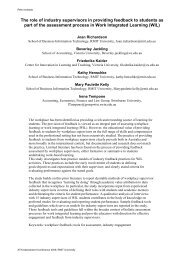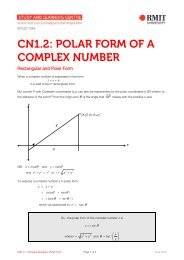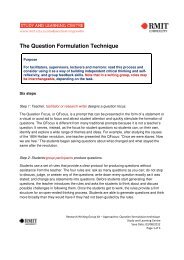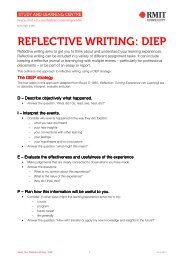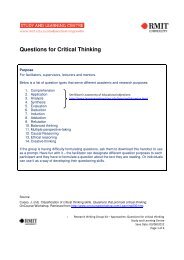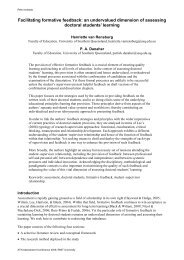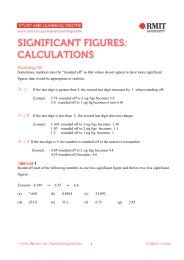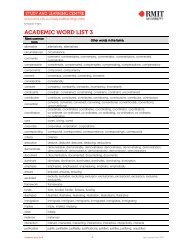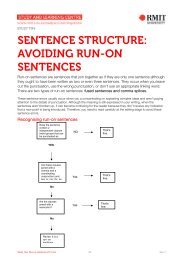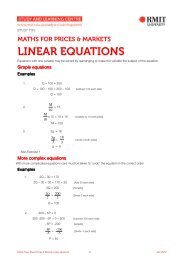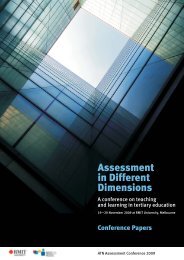student feedback and leadership - Office for Learning and Teaching
student feedback and leadership - Office for Learning and Teaching
student feedback and leadership - Office for Learning and Teaching
You also want an ePaper? Increase the reach of your titles
YUMPU automatically turns print PDFs into web optimized ePapers that Google loves.
Part B: Building Leadership Capacity<br />
Introduction<br />
Part B presents the experience of the three Action Research Teams established<br />
as part of this project to create a shared sense of purpose between members<br />
in using <strong>student</strong> <strong>feedback</strong>. As outlined in Part A the three ARTs represented<br />
each of the three academic Colleges (Business, Design <strong>and</strong> Social Context <strong>and</strong><br />
Science, Engineering <strong>and</strong> Technology) of the University. These three disciplinary<br />
areas identified low levels of <strong>student</strong> satisfaction in some areas <strong>and</strong> volunteered<br />
to become part of this project as follows:<br />
––<br />
School of Economics, Finance <strong>and</strong> Marketing, College of Business<br />
(Case Study 1).<br />
Four courses were chosen from primarily core first year courses<br />
in Business Statistics, Marketing Principles, Macroeconomics, <strong>and</strong> Prices<br />
<strong>and</strong> Markets. These courses are common to a number of undergraduate<br />
Business degrees with a total of 1000-1500 <strong>student</strong>s (onshore) per year<br />
in lecture cohorts. The issue chosen was courses with large enrolments<br />
<strong>and</strong> low <strong>student</strong> satisfaction.<br />
––<br />
School of Property, Construction <strong>and</strong> Project Management,<br />
College of Design <strong>and</strong> Social Context (DSC) (Case Study 2).<br />
Two courses were chosen, one a final year course in Construction<br />
Management with 85 <strong>student</strong>s <strong>and</strong> the other a first year course<br />
in Computer Aided Drafting with 21 <strong>student</strong>s. The issue chosen<br />
was teaching capabilities in course delivery, including how teaching<br />
capabilities were affected by the quality of the learning environment<br />
which has affected <strong>student</strong> satisfaction.<br />
––<br />
School of Mathematical <strong>and</strong> Geospatial Sciences, College of Science<br />
Engineering <strong>and</strong> Technology (SET) (Case Study 3).<br />
Two courses in mathematics are taught as ‘service’ courses across<br />
a broad range of Programs, each with 220 <strong>student</strong>s from mixed<br />
disciplines. The issue chosen was service teaching large classes<br />
which affect <strong>student</strong> satisfaction.<br />
The ARTs were supported by small incentive grants to assist their activities.<br />
Each ART retained ownership of their contribution to the project activities.<br />
While the focus of these case studies is on actions taken by the ARTs<br />
aimed at improving <strong>student</strong> <strong>feedback</strong>, they each demonstrate <strong>leadership</strong><br />
capacity building in the design, implementation <strong>and</strong> assessment of strategies<br />
implemented. Each of the case studies demonstrate the need <strong>for</strong> holistic<br />
change <strong>leadership</strong> to improve <strong>student</strong> learning <strong>and</strong> teaching as summarised<br />
in the R.E.A.L.I.S.E.D Change Management Model presented in Part One.<br />
In each case study action by individual academics (<strong>and</strong> teams of academics)<br />
to change their teaching practice requires an interlinked supportive process.<br />
Change in teaching practices introduced in the case studies includes:<br />
––<br />
Use of technology to provide <strong>student</strong>s with instant <strong>feedback</strong> on their<br />
underst<strong>and</strong>ing of key concepts <strong>and</strong> individual per<strong>for</strong>mance relative<br />
to peers <strong>and</strong> to provide additional commentary <strong>and</strong> <strong>feedback</strong><br />
to <strong>student</strong>s on key points raised in lectures <strong>and</strong> by <strong>student</strong>s.<br />
––<br />
Introduction of ‘drop-in’ sessions to supplement lectures <strong>and</strong> tutorials.<br />
Page 85



